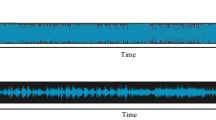Abstract
Effect of a type of Indian classical music (Raag Kirwani) comprised of the sound corresponding to a frequency range of 38–689 Hz, on microbial growth, production of certain important metabolites, and antibiotic susceptibility was investigated. All the bacteria and yeasts used as test organisms were found to register better (3.15–40.37% higher) growth under the influence of music, except Serratia marcescens. Music treatment was also found to affect production of bacterial pigments (prodigiosin and violacein) whose production is normally linked with quorum-sensing in the producing bacteria. All the test organisms exhibited an increased antibiotic susceptibility (increase ranging from 3.81–18.69%) under the influence of music. Chromobacterium violaceum and S. marcescens were found to degrade cephazolin at a faster rate when incubated with music. Membrane permeability of the test organisms seemed to get altered owing to music treatment. Intracellular concentration of cations (calcium and potassium) and protein content of the music treated cultures was also significantly different than the untreated control. The audible sound in form of music employed in this study was able to affect growth, metabolism, and antibiotic susceptibility of prokaryotic as well as eukaryotic microbes.
Similar content being viewed by others
References
Butler, M., Cells and sound: an introduction, Physical Biology Articles. http://www.academia.edu/1285421/Cells_and_sound_an_introduction_Review_to_be_submitted_2013
Matsuhashi, M., Pankrushina, A.N., Takeuchi, S., Ohshima, H., Miyoi, H., Endoh, K., and Sawada, T., Production of sound waves by bacterial cells and the response of bacterial cells to sound, J. Gen. Appl. Microbiol., 1998, vol. 44,1, pp. 49–55.
Ying, J.C.., Dayou, J., and Phin, C.K., Experimental investigation on the effects of audible sound to the growth of Escherichia coli, Modern Appl. Sci., 2009, vol. 3, no. 3, p. 124.
Hou, T.Z., Luan, J.Y., Wang, J.Y., and Li, M.Y., Experimental evidence of a plant meridian system: III. The sound characteristics of Phylodendron (Alocasia) and effects of acupuncture on those properties, Am. J. Chin. Med., 1992, vol. 22, pp. 205–214.
Xiujuan, W., Bochu, W., Yi, J., Chuanren, D., and Sakanishi, A., Effect of sound wave on the synthesis of nucleic acid and protein in Chrysanthemum, Colloids and Surfaces B: Biointerfaces, 2003, vol. 29, no. 2, pp. 99–102.
Braam, J., In touch: plant responses to mechanical stimuli, New Physiol., 2005, vol. 165, pp. 373–389.
Shaobin, G., Wu, Y., Li, K., Li, S., Ma, S., Wang, Q., and Wang, R., A pilot study of the effect of audible sound on the growth of Escherichia coli, Colloids and Surfaces B: Biointerfaces, 2010, vol. 78, no. 2, pp. 367–371.
Choo, J. H., Rukayadi, Y., and Hwang, J.K., Inhibition of bacterial quorum sensing by vanilla extract, Lett. Appl. Microbiol., 2006, vol. 42, no. 6, pp. 637–641.
Pradeep, B.V., Pradeep, F.., Angayarkanni, J., and Palaniswamy, M., Optimization and production of prodigiosin from Serratia marcescens MBB05 using various natural substrates, Asian J. Pharm. Clin. Res., 2013, vol. 6, no. 1.
Murillo, J.A., Lemus, J.M., and García, L.F., Simultaneous determination of 7-aminocephalosporanic acid and 7-aminodesacetoxycephalosporanic acid by second derivative spectrophotometry, Anal. Lett., 1991, vol. 24, no. 4, pp. 683–699.
Nikaido, H., Molecular basis of bacterial outer membrane permeability revisited, Microbiol. Mol. Biol. Rev., 2003, vol. 67, no. 4, pp. 593–65.
Harley, J.P., and Prescott L.M., Laboratory Exercises in Microbiology, 5th ed., McGraw Hill, 2000.
Stern, J. and Lewis, W.H.P., The colorimetric estimation of calcium in serum with O-cresolphthalein complexone, Clin. Chim. Acta, 1957, vol. 2, no. 6, pp. 576–580.
Kaneko, T., Matsuhashi, M., and Otani, S., U.S. Patent 5,955,334, 1999.
Yoshimura, M. et al., “Sound wave” signals, emitted by bacteria and yeast cells, regulate the propagation of yeast under alcohol stress, Japan Soc. Biosci., Biotechnol. Agrochem., Aug. 1, 1995, Conference Abstracts.
Pornpongmetta, S. and Thanuttamavong, M., Effects of music on microbial substrate utilization of aerobic bacteria from municipal wastewater treatment plant part II: Comparative effects of musical characteristics, 2010. http://www.ncbi.nlm.nih.gov/pmc/articles/PMC2394891/
Ayan, I., Aslan, G., Comelekoglu, U., Yilmaz, N., and Colak, M., The effect of low intensity pulsed sound waves delivered by the exogen device on Staphylococcus aureus morphology and genetics, Acta Orthop. Traumatol. Truc., 2008, vol. 42,4, pp. 272–277.
Sen, K. and Nikaido, H., In vitro trimerization of OmpF porin secreted by spheroplasts of Escherichia coli, Proc. Natl. Acad. Sci. U. S. A., 1990, vol. 87, no. 2, pp. 743–747.
Wang, B., Zhao, H., Wang, X., Duan, C., Wang, D., and Sakanishi, A., Influence of sound stimulation on plasma membrane H+-ATPase activity, Colloids and Surfaces B: Biointerfaces, 2002, vol. 25, no. 3, pp. 183–188.
Ackerman, E., Resonances of biological cells at audible frequencies, The Bulletin of Mathematical Biophysics, 1951, vol. 13, no. 2, pp. 93–106.
Martinac, B., Mechanosensitive ion channels: an evolutionary and scientific tour de force in mechanobiology, Channels, 2012, vol. 6, no. 4, p. 211.
Berry, R. M., Turner, L., and Berg, H.C., Mechanical limits of bacterial flagellar motors probed by electrorotation, Biophysical. J., 1995, vol. 69, pp. 280–286.
Walley, J.W. and Dehesh, K., Molecular mechanisms regulating rapid stress signaling network in Arabidopsis, J. Integrative Plant Biol., 2010, vol. 52, no. 4, pp. 354–359.
Norris, V. and Hyland, G.J., Do bacteria sing? Sonic intercellular communication between bacteria may reflect electromagnetic intracellular communication involving coherent collective vibrational modes that could integrate enzyme activities and gene expression, Mol. Microbiol., 1997, vol. 24, no. 4, pp. 879–880.
Reguera, G., When microbial conversations get physical, Trends Microbiol., 2011, vol. 19, no. 3, pp. 105–113.
Author information
Authors and Affiliations
Corresponding author
Additional information
The article is published in the original.
Rights and permissions
About this article
Cite this article
Sarvaiya, N., Kothari, V. Effect of audible sound in form of music on microbial growth and production of certain important metabolites. Microbiology 84, 227–235 (2015). https://doi.org/10.1134/S0026261715020125
Received:
Published:
Issue Date:
DOI: https://doi.org/10.1134/S0026261715020125




